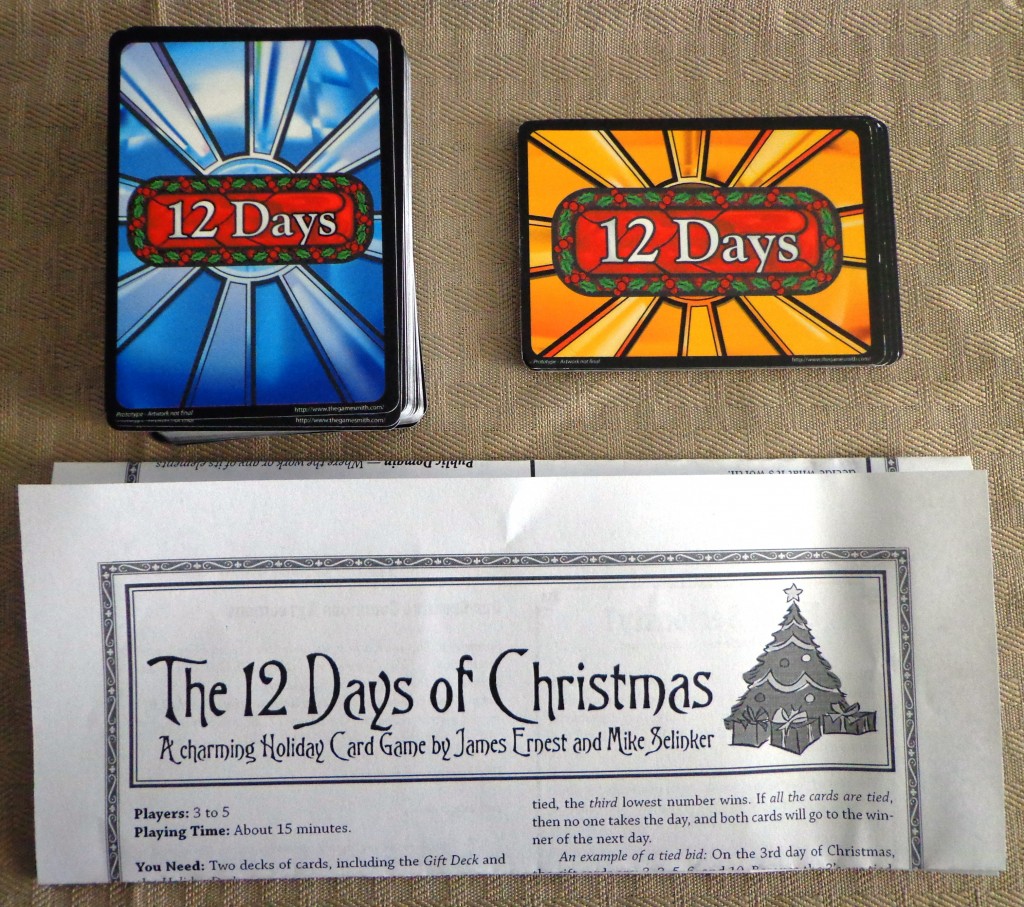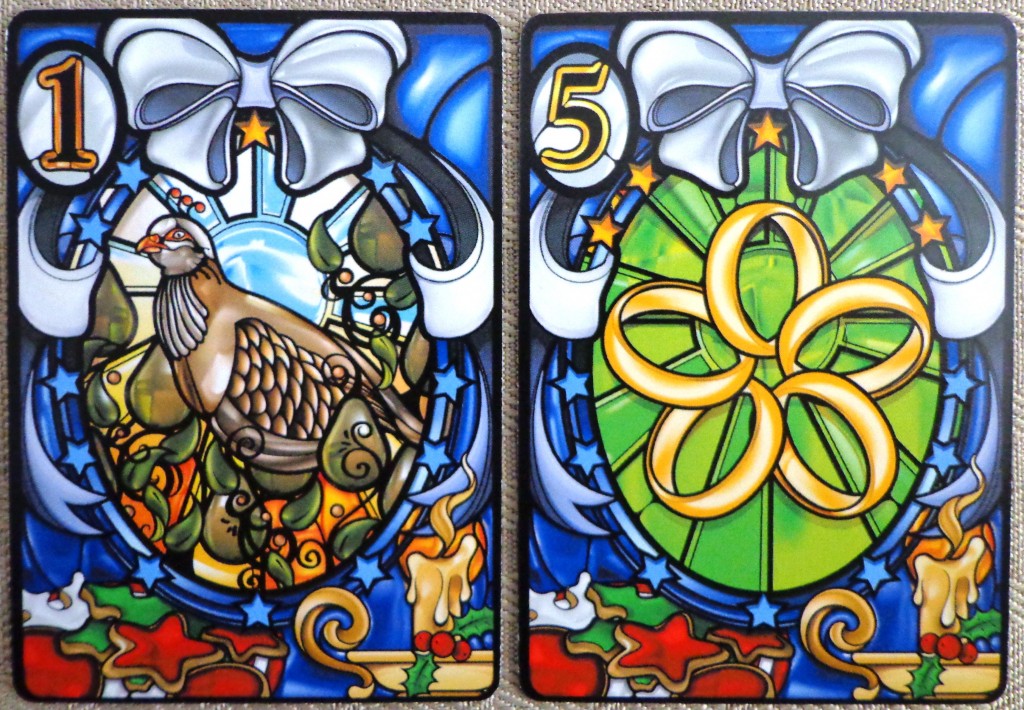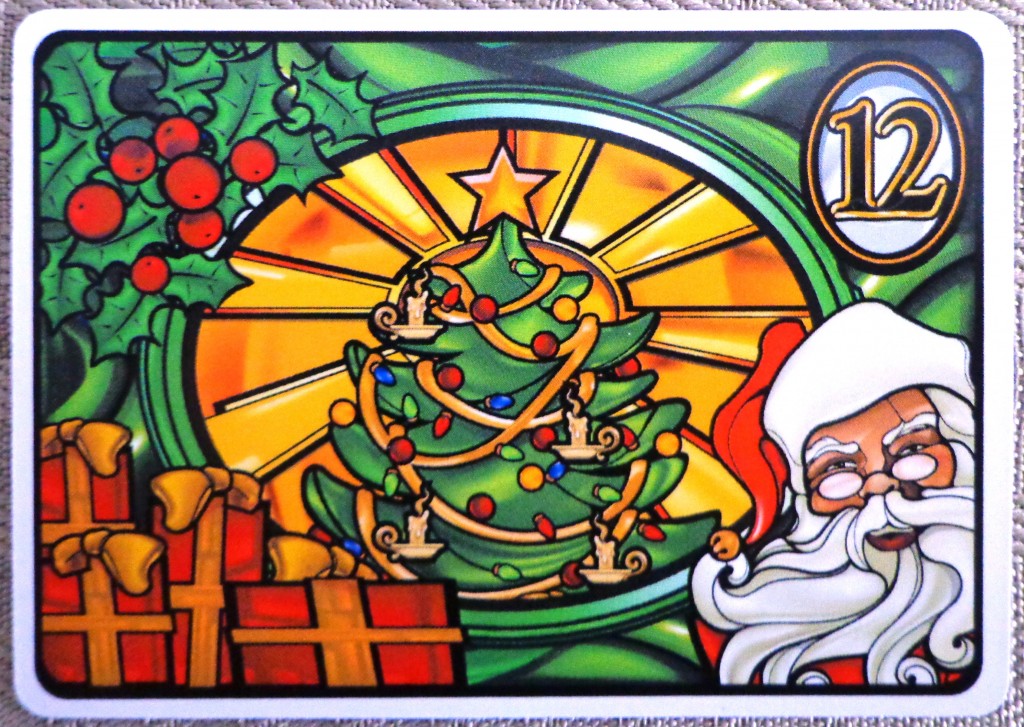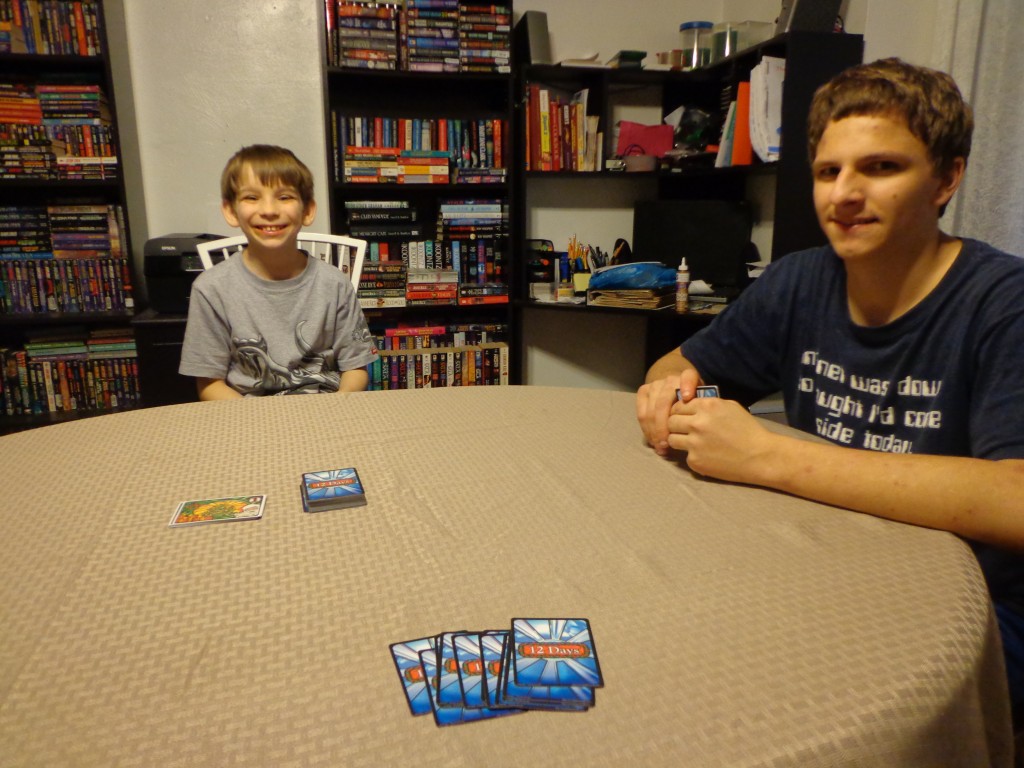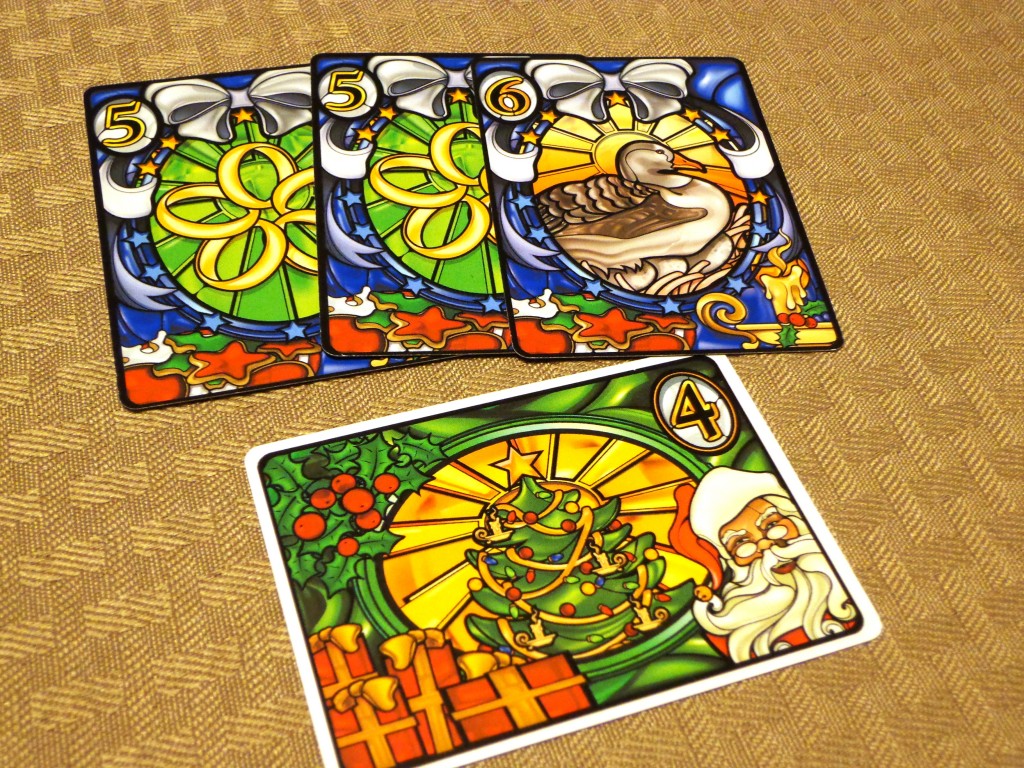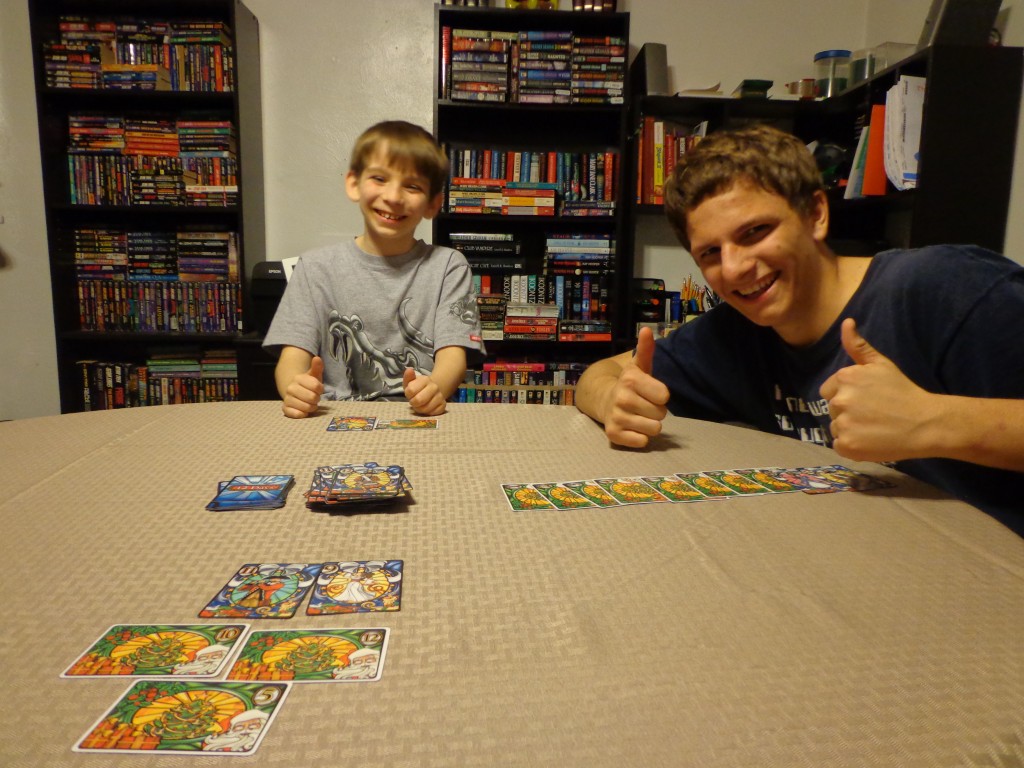If retail stores are any indication, it’s never too early to start celebrating Christmas. My local Kmart store already has rows of pre-decorated, fake trees available that are ready to bring joy to kids everywhere come Christmas morning…nevermind that we haven’t even gotten to Halloween or Thanksgiving yet. Today, we’re going to take a look at a game that might very well be the ultimate stocking stuffer for gamer families everywhere.
“12 Days” is a Christmas themed card game that is based around, you guessed it, the Twelve Days of Christmas. Players will be passing cards around and playing them in an effort to score the most points and win the game. Before we begin taking a look at the game in further detail, I’d like to quickly thank Todd Silverstein from Gamesmith for sending me a free review copy. It should be noted that because the game was recently funded through Kickstarter that some of the components I received are not final. While the rulebook and packaging (a plastic band) are prototypes, the artwork on the cards are final. I’m told that the rulebook in the retail copy will include variants that players may choose to take advantage of.
Components
Gift Cards – The gift deck contains a total of eighty cards, made up of all of the things you’d find on the Twelve Days of Christmas (1 Partridge in a Pear Tree, 2 Turtle Doves, 3 French Hens, etc.) plus a Santa Claus card and a Mrs. Claus card.
Holiday Cards – The holiday deck is made up of twelve cards, each numbered for the Twelve Days of Christmas.
Setup & Gameplay
The holiday deck is arranged in numeric order, placed face up, with the “1” card on top. The gift deck is shuffled and each player receives twelve cards.
There are a total of twelve rounds (days) and each round is played out the same way, as follows:
1) Pass a card to the left – Each player will pass a card, in secret, to the person on their left.
2) Play a card – Each player will play a gift card, face down, and reveal them all at once when everyone is ready. The person with the lowest valued card will take the holiday card shown at the top of the pile and place it into a scoring pile in front of them. In case of ties, the person with the next lowest number receives the holiday card. Santa and Mrs. Claus act as 0’s, but can still cancel each other out. Gift cards played this round are discarded.
Editor’s Note: I’m told that in the deluxe version of the game, Santa and Mrs. Claus wins the day and the player who won picks someone else to win that day.
3) Draw a card – Each player draws a card from the gift deck. At the end of the round, everyone should have twelve cards in their hand.
Play continues until all twelve holiday cards have been claimed. After that, scoring occurs in two steps.
1) Players tally the point values listed on their holiday cards, if they have any.
2) Players compare gift cards to see who has the most of each number in their hand. Whoever has the most of a number keeps one card (for scoring purposes) and discards the rest. Everyone else discards all of their cards of that number. In case of ties, both / all players receive the point value listed on the card. After all twelve numbers have been compared, players tally their awarded gift cards.
The winner is the person with the most points, that is, the sum of the values on the holiday and gift cards.
The above is simply an overview of the game, but should still give you an idea of how it is played. I included a link to the prototype rulebook at the end of this article should you seek more information.
The Review
First, I’d like to touch on the quality of the components. The artwork on the cards themselves are superbly beautiful. The artist (Echo Chernik) put a lot of effort into making these cards look eye-catching and it shows. As I started earlier, my manual was a prototype copy so I really can’t comment on how the information was laid out. The prototype copy was only a couple of pages (or one page front and back) and some of that was history of the product, legal stuff, and instructions on how to make your own deck. If the final copy of the manual includes all of these things plus a couple of variants to try out, then it would receive a kudos from me. With that said, please keep in mind that the rules I mentioned above may or may not be slightly different than the rules listed in the final copy.
The game itself is very simple, but the way scoring works makes one stop to think. Instead of shooting for one goal, you’re really aiming for two. Not only are you trying to play enough low gift cards to win the holiday cards, but you’re trying to get as many of the same gift cards as you can. You also have to consider that you’ll be passing cards to your left every turn. While some might see it as a great opportunity to get rid of cards they don’t want or need, there’s a chance that’ll you be seeding that person with the cards they do need. An observant player will take note of what cards they are playing to win those holiday cards and try to seed them those same valued cards, as they obviously don’t need them that badly if they are playing them. Then again, sometimes you may not have a choice if they end up playing a lot of low cards…you’ll want to be saving those for yourself to win those holiday cards.
The kids and I had a fun time playing the game. Anthony (16) scooped up a lot of holiday cards early on whereas I saved my low gift cards for the “10”, “11”, and “12” holiday cards. I tried my best to save as many of the high gift cards as I could to get those points in scoring, but I was always at ends when it came time to pass a card to the left. We learned that it requires a good deal of balance between the two scoring mechanisms in that it isn’t wise to ignore one or the other. Vinnie (11) took a lot of pleasure in gifting Anthony the same number over and over again. Anthony ended up with so many of that card that he didn’t have room in his hand for anything else. There were a lot of laughs and the kids expressed an interest in playing the game again immediately afterwards.
Overall, “12 Days” is a good mix of strategy and luck. The gameplay mechanics are simple enough in that it will appeal to players of all ages, but the scoring mechanics are involved enough to where players will need to give thought to what cards they play. Playing a game of “12 Days” only takes about fifteen minutes, making it work well as a portable game that friends or families can quickly play in between activities. Best of all, it has a Christmas theme to it, though you don’t have to celebrate or understand the holiday in order to play it. If you’re looking to spread a little joy during the holiday season, then you can’t go wrong with “12 Days.”
Editor’s Note: Milk, cookies, and eggnog not included.
The game is expected to arrive in stores late December 2012 / early January 2013, though I’m told that Kickstarter backers should have theirs mid December 2012. Gamesmith expressed their desire to release the game sooner, but the manufacturing process and the time of year messed with their timetable a bit.
You can read more about “12 Days” on The Gamesmith website and on BoardGameGeek, located here:
http://www.boardgamegeek.com/boardgame/130899/12-days
You can download a free copy of the prototype / print-and-play version (includes rulebook) here:
http://www.cheapass.com/freegames/12days
—
—

